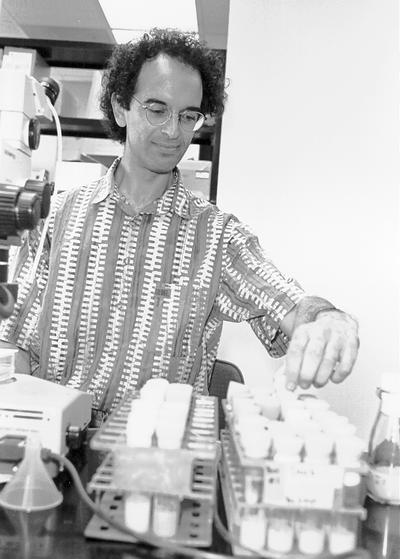Investigator 'points' way toward nervous system's development

Dr. Chand Desai is investigating whether 'signpost' molecules help guide the development of the nervous system. (Photo by Donna Marie Jones)
A VUMC researcher is exploring the idea that signpost molecules may explain the way the nervous system forms.
Recent research into the nervous system indicates that during growth neurons guide themselves through the maze of muscle, bone, and skin by reading the molecules on the cells around them, which act like road signs.
Neurons, which allow the cells in the body to communicate with each other, have long wire-like appendages called axons. The axon that runs from the spine to the foot is up to a meter long in humans.
"This long connection is essential so that the connection is continuous and so that the right muscle moves when you want it to," said Dr. Chand Desai, assistant professor of Pharmacology.
Each axon has a specific route that it is programmed to take during growth and a certain muscle that it is supposed to connect with. It is not yet known how the axons know where the muscle is, or how they follow the correct path to get to that muscle.
Desai's research is dedicated to discovering the mechanisms by which axons thread themselves to the right muscle.
By studying the fruit fly, which has only one neuron for each muscle fiber, Desai has been able to look more closely at how the neuron develops and interacts with the muscle.
Using a 70 power microscope and a wire that is sharpened to .1 millimeters, Desai is able to lay bare the delicate interactions of the neurons and muscles.
"The same neuron in every normal fruit fly always talks to the same muscle, so it is a much simpler process in the fruit fly then it is in humans," said Desai.
One way that the axons may find the right muscle fiber is by sensing signposts that tell the tip of the axon where to go.
"What we have found is that there are molecules on the inside and outside of these axons. The molecules on the outside look as if they could bind to other proteins. If that is true then they could sense differences in the environment and interpret these differences as signs telling the axon to turn or stop," said Desai.
This model of neurons would be like following the road signs while driving your car. As long as the way is clearly marked you won't get lost.
Sometimes, however, mutations in the fly's genes occur that make the axons turn incorrectly or stop where they are not supposed to.
"In the mutants where the axons do not reach their target muscle fibers, the molecules are missing from the axon," said Desai.
The molecules on the inside of the axons are believed to tell the axon that it has found its target, said Desai.
When these interior molecules are activated the axon stops growing and makes its connection with the muscle.
Studying the different types of mutations that block axons from reaching their destinations will allow scientists to glean a better understanding of not only fruit flies but the human body as well.
"As of now, we are researching the genetic aspects of neuron growth but that could one day lead to advances in the treatment of spinal cord injuries and other diseases of the brain and spinal cord," said Desai.













